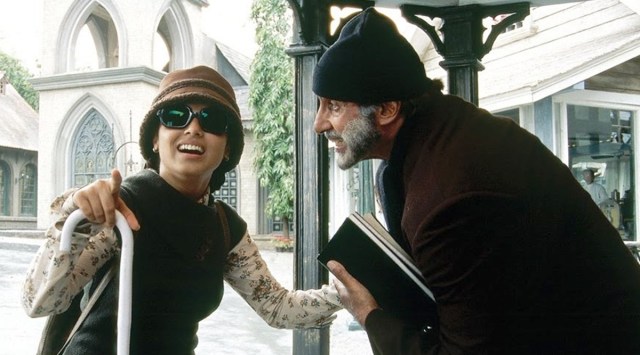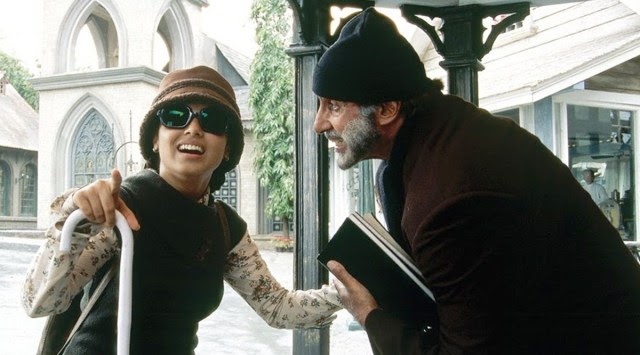
Niharika Lal (BOMBAY TIMES; February 8, 2025)
From its characters and settings to the interplay of light and darkness, Black told a unique story with an exceptional cast. As the film marks 20 years, we reflect on the making of this cinematic masterpiece.
On the 20th anniversary of Black, director Sanjay Leela Bhansali says, “Black is a film that means a lot to me. I’m grateful for the love it has received from the audience, and for the incredible performances of Amitabh Bachchan, Rani Mukerji, Ayesha Kapur, and Shernaz Patel, along with all the talented technicians who made it so special. It’s overwhelming to see that, even after 20 years, Black still touches people’s hearts.”
The film’s writer, Bhavani Iyer, revisits Black, a film that marked her screenwriting debut. Bhavani Iyer says, “Sanjay involved me in every part of the filmmaking process. On set, he’d ensure that I had a chair next to him. I couldn’t have asked for a better start in the film industry.”
Over the years, she wrote films like Lootera, Guzarish, Raazi, and Sam Bahadur, but when she started working on Black, she was still in her 20s, and says, “Sanjay never tried to manipulate my writing. There was never an attempt to do anything that was not true to the writing. And that spoiled me for life because that is what I look for in all my collaborations since I found it in that film. The way Sanjay stuck to the script is something that helped me understand how important writing is and how crucial the script is.”
‘Sanjay wanted to explore a biopic based on the life of Helen Keller’
Bhavani Iyer made her screenwriting debut with Sanjay Leela Bhansali’s Black. Narrating the story of how Black came about, she recalls, “I knew Vikramaditya Motwane; he had assisted Sanjay before. Sanjay had just finished Devdas, and he wanted to meet writers and explore different subjects. Sanjay spoke to me about two subjects he wanted to explore – one was a remake of Balika Vadhu, and the other was a biopic based on the life of Helen Keller. I found the Helen Keller idea very exciting. I had not watched too many films in my life – I was very young and in my 20s at the time. I had also read William Gibson’s play The Miracle Worker (about Helen Keller). That was the play Sanjay wanted to base the film on. My first meeting with him was on March 28, and by April 15, I had my first draft ready for him to read. Things escalated quickly, and by December that year, we were already shooting the film.”
There were some issues with the rights, so the story was fictionalized. Bhavani says, “Sanjay involved me in every part of the filmmaking. On set, he’d ensure that I had a chair next to him. I could not have asked for a better start in the film industry.”
‘We wanted the teacher to be slightly unlikeable’
Bhavani Iyer shares that the characterizations were strongly defined in the first few days of writing.
She says, “Both Sanjay and I agreed with my suggestion that the teacher should be slightly unlikeable. He (Amitabh Bachchan’s character, Debraj Sahai) is politically incorrect. He doesn’t have a filter. He takes charge. I also felt that a teacher working with someone with special needs can’t have too many filters, as they need to take charge of the pupil. The film is set during a time when there were not many schools for children with special needs. The teacher is in a phase of his life when he is retiring. What happens is that as we age, we don’t really care about the world or what people think. So, Debraj’s character is at a stage where he doesn’t care about anything but the job at hand – that kind of lends eccentricity to him. I also wanted him to be a poetry lover, quoting poetry. We kept exploring him through writing, and then Mr. Bachchan came in and gave him a completely different life altogether.”
From the beginning, I was clear that there comes a point when the student becomes the teacher.
Bhavani recalls that she thought it would be interesting to tell the story as a relationship between a teacher and a student as it’s not a subject that has been explored much in our films. She says, “Sanjay also loved the idea. We decided to make the gender of the teacher male, as it would give us more opportunities to explore the teacher-student dynamic. That worked out beautifully. We felt that if we wanted to make the film in English, the family had to be anglo-Indian.”
However, she says that it could not have been just a story of a student and a teacher; it would have become too linear. From the beginning, she was clear that there comes a point when the student becomes the teacher.
She says, “The freedom of words that the teacher gave to Michelle – he needed to lose those words. I have seen people with Alzheimer’s in my life, so I knew what it does. I knew what it can do to people, especially those with such a felicity for words. Whether it’s a teacher or a writer, for them to lose words is devastating – I know that. So, I needed Michelle’s triumph of graduating to be bittersweet. There is a gasp of light when she recognizes that movement – when Debraj touches the graduation hat, which was once the dance of failure but now turns into the dance of victory. I feel that, many times, you just need the right teacher or the right push to realise what you’re capable of.”
‘Story had to be set in a surreal place’
Because of the snow, landscape, and the visual narrative that Sanjay Leela Bhansali wanted for the film, Shimla was chosen as the setting for the story. “The story had to be set in a place that is surreal and has an element of magic realism – like the scene where Michelle finds her teacher completely covered in snow,” she recalls.
She says, “I think we benefitted in Black from some incredible casting and performances, with actors who brought much more to the characters than one could have imagined.”
‘The title was Black because, right from the phonetics, we wanted to draw the audience into the world that is hers’
The film has a number of dialogues about darkness and light. Sharing her thought process behind it, Bhavani says, “There is a scene where Debraj locks Michelle in a room and the lights go off. Here she has the advantage, like he says – ‘Without light, what’s the use of sight?’ Constantly, the idea was between lightness and darkness, and that was the thought because that’s the world Michelle inhabits. Even the title was Black because it needed that, right from the phonetics, to draw the audience into the world that is hers, which we wanted them to know and experience. Even in the visual setting, Sanjay did his best, and so did the DOP Ravi K. Chandran. Darkness and light were constantly endeavoured throughout the film – whether it was the white snow, the white corridors of the hospital, or the black walls of the house. The monochromatic theme was something we constantly endeavoured, whether it was in the visuals or clothes.”
“Both Debraj and Michelle have qualities that I think are somewhat borrowed from my own life. The teacher that he is, is a lot like my dad – the teacher that my dad was. My dad was a very gentle person as opposed to Debraj. All that I know about my craft and the art of writing is what I learned from my father, and that is reflected in Michelle’s speech when she talks about how she grew from strength to strength, all thanks to her teacher,” says Bhavani Iyer.
Talking about writing the character of Michelle, she says, “Michelle, to me, is someone whose handicap doesn’t define her. She’s not just a deaf and mute girl – she is a woman with a purpose, and she wants to achieve something, which, in her case, is graduation. It didn’t matter to her that she had a handicap. She needs to achieve what she has set out to do.”
She shares, “Shernaz (Patel) brought the mother’s character the quiet strength, which is what we wanted. We didn’t want the mother to be overbearing because the father was a tougher man, like some fathers who are not given to expressing love. He may love the child, but at this point, the child is an inconvenience, and he doesn’t know any other way to resolve this other than sending her away. So, we needed the mother to be quiet and strong. Shernaz lent such gravitas to the character; you could see her strength, and you could see that she was unflinching and unshakeable.”
Sabyasachi Mukherjee won the National Award in 2005 for Best Costume Designer for this film. “Black is a period film set in the 1960s. The plot necessitated my using a lot of monochromatic colours like grays, blacks, beige, browns, khakis, and indigo. I deliberately worked towards lending a definite colourlessness to the film,” he said during the release of the film in 2005.
Trivia
– Halfway through the schedule, the original set of Black was destroyed in a fire at Film City. To maintain continuity, the entire set was meticulously rebuilt with every detail carefully recreated.
– Almost everyone working on the film, spent a couple of months learning ASL (American Sign Language)
– The film won three National Awards. Amitabh Bachchan for Best Actor, Sabyasachi Mukherjee for costume and the Best Feature Film

